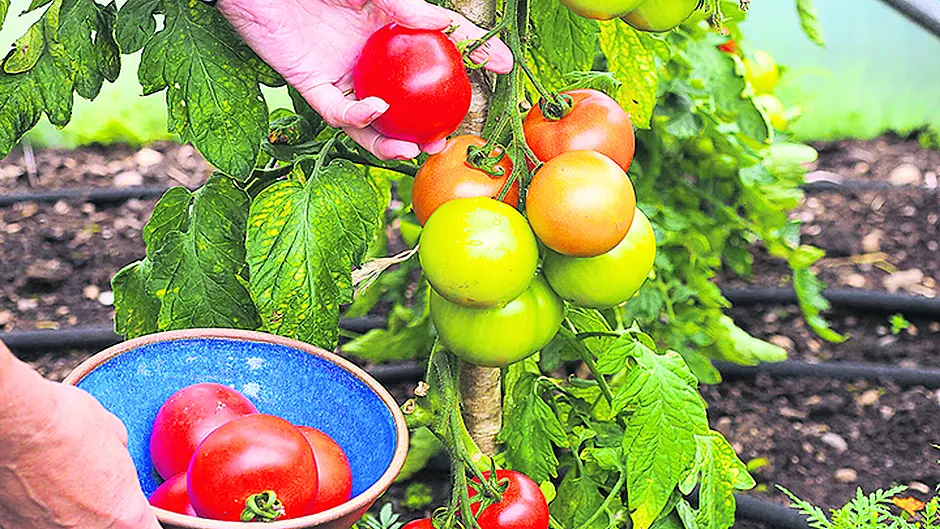We've finally had some rain – and what a gift it was for our gardens.
Gardening with Joyce Russell
WE’VE finally had some rain – and what a gift it was for our gardens. Whatever the forecast for the rest of the summer, we’ll just have to keep moving along and doing the best that we can for our plants. Some will suffer, a small few may never recover, but surprisingly most will demonstrate a remarkable ability to survive and thrive once we return to more normal weather.
Tasty tomatoes
Fruit is ripening well and there are lots of green trusses swelling right up the plant. There should be a mix of ripe, semi-ripe and green fruits on each truss so there is no longer a need to leave one ripe fruit at the top to encourage lower ones to ripen. Harvest when tomatoes are firm and well coloured – they should be at their delicious best for eating raw and slightly riper for use in cooking.
Tomatoes are thirsty plants and they like to be fed every seven to 10 days while swelling fruits. They thrive in good summer weather provided roots don’t dry out. In fact, this summer has been one of the best for a long while for ripening fruit on outdoor plants. You will lose less moisture from evaporation if you water deeply and use a thick layer of mulch round plants. This means carrying less water to each plant. You can use mulch in pots and containers too – water well and cover the top of the compost with a layer of gravel, bark chip, grass clippings, or use polythene – lift this up or cut a hole to allow for watering. You can cover growbags with an extra layer of insulating material to keep moisture in and this will also keep roots a little cooler in the compost.
Leaves will suffer from fewer fungal diseases if they are kept dry, so keep water where it is needed and don’t spray tomato plants.
Nothing faulty about basil
This plant does very well in barely damp soil that mimics a Mediterranean climate. A small drop of water around the roots, goes a long way to keep plants growing and leaves are more pungent if grown in a warm dry environment.
Harvest leaves before plants flower and nip off any flower spikes if you spot them growing. Nip off clusters of leaves at the top of stems rather than picking individual leaves lower down. This allows new clusters to grow from the leaf joints below. Don’t strip all leaves from a plant – some are needed to feed new growth.
Basil is a wonderful addition to many meals and if you have an excess you can chop the fresh herb and freeze this in a little water in ice cube trays.
Act fast before cut leaves discolour. And if you have lots of this wonderful herb, make pesto to use fresh or freeze some in tubs to bring a taste of summer into the wintertime.
Fiddly fruits
There was plenty of blossom, then plenty of fruits to follow on most garden trees and bushes. The problem is that lack of water can lead to smaller sized and slightly less juicy fruits. This intensifies flavour and sweetness, but causes a few problems to do with handling. Smaller fruits are fiddly to prepare and some may not store so well through the winter.
With redcurrants the individual stems are tending to stay in place when berries are stripped from bunches – what is already a slow and patient job can become even slower and more tedious. If you have lots of berries to prepare for the freezer, then do bear in mind that a few small stems aren’t a big problem. They soften with freezing/thawing and are often cooked afterwards so they are barely noticed.
Fruit trees have had a tough time this year. The masses of blossom arrived a month late and a lot of small fruitlets dropped with the drought. It is probably best if trees don’t carry a huge crop at this time. Better to hope for a smaller number of good fruits than to keep pressure on the tree by allowing them to carry a large crop.
Sowing seeds
Sow spring cabbage, Swiss chard, spinach, salad leaves, lettuce, pak choi, kohl rabi, turnip, parsley etc. for autumn and winter use. Seedlings require only small amounts of water but keep them out of direct bright sun until they have established a reasonable root system. By the time these plants go out into garden and greenhouse beds, the conditions may suit them better.
You can also sow rows of kale to use as cut-and-come-again leaves while small. Or try planting three sprouted seed potatoes in a sack of compost. Use early varieties only and they should grow fast. Fill the bag with compost to earth up around stems as they grow.








